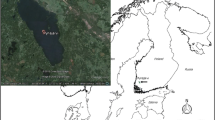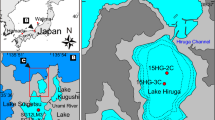Abstract
Lake Vesijärvi was loaded by sewage from the City of Lahti for 60 years until 1976 when the discharge was diverted. Paleolimnological analyses of the varved bottom sediment indicate that the sedimentation rate within the Enonselka basin, the most eutrophic part of the lake, has been as high as 2 cm yr−1, and total phosphorus accumulation was 20–40 g P m−2 yr−1, during the last 20 years. Within the less eutrophic Laitialanselkä basin, the sedimentation rate did not exceed 1 cm yr−1, and the formation of varved sediment only began at the end of the 1960's, i.e. about 10 years later than in Enonselkä.
Planktonic diatom production was highest in the Enonselka basin. The most abundant diatoms in the sediment between 1970–1985 were Asterionella formosa, Aulacoseira islandica and Stephanodiscus spp. Fragilaria crotonensis and Tabellaria fenestrata had low abundances in the middle of the 1970's but increased again at the end of the 1970's. Asterionella formosa and Diatoma elongatum reached their maxima between 1979–1984 when the hypolimnion of the Enonselk/:a basin was aerated artificially. In the Laitialanselkä basin, the production of planktonic diatoms has been lower and the species composition of the diatom community differed from that in Enonselkä. However, at the end of 1980's the total accumulation of diatoms in Laitialanselkä approached levels which were observed at the end of 1950's in Enonselkä, prior to the rapid eutrophication period.
The production and thereby the sedimentation of diatoms has decreased towards the end of the 1980's in Enonselkä, indicating reduced nutrient availability in the lake water. This reduction was due to the decreased external loading of phosphorus as well as to the decreased release of phosphorus from the sediment as a result of improved oxygen balance in the hypolimnion.
Similar content being viewed by others
References
Allen, S. E. (ed.), 1974. Chemical analysis of ecological materials. Blackwell Scientific Publications, Oxford, 565 pp.
Anderson, N. J., 1989. A whole-basin diatom accumulation rate for a small eutrophic lake in northern Ireland and its palaeoecological implications. J. Ecol. 77: 926–946.
Anderson, N. J., B. Rippey & A. C. Stevenson, 1990. Change to diatom assemblage in a eutrophic lake following point source nutrient re-direction: a palaeolimnological approach. Freshwat. Biol. 23: 205–217.
Battarbee, R. W., 1984. Spatial variations in the watrer quality of Lough Erne, Northern Ireland, on the basis of surface sediment diatom analysis. Freshwat. Biol. 14: 539–545.
Cleve-Euler, A. 1951–1955. Die Diatomeen von Schweden and Finnland. Kungl. Svenska Vetenskapsakad. Handl. Ser 4 2(1): 1–163, 3(3):1–153, 4(1):1–158, 4.(5):1–255, 5.(4):1–231.
Engstrom, D. R., B. Swain & J. C. Kingston, 1985. A paleolimnological record of human disturbance from Harvey's Lake, Vermont: geochemistry, pigments and diatoms. Freshwat. Biol. 15: 261–288.
Hartig, J. & Wallen, D., 1986. The influence of light and temperature on growth and photosynthesis of Fragilaria crotonensis (Kitton). J. Freshwater Ecol. 3: 371–382.
Horppila, J. & T. Kairesalo, 1990. A fading recovery: The role of roach (Rutilus rutilus L.) in maintaining high phytoplankton productivity and biomass in Lake Vesijärvi, southern Finland. Hydrobiologia 200/201: 153–165.
Hustedt, F., 1930. Bacillariophyta (Diatomae). Die Süswasser-Flora Mitteleuropas, 10, 2nd edn. G. Fischer, Jena, 466 pp.
Hustedt, F., 1927–1966. Die Kieselalgen Deutschlands, Osterreichs and der Schweiz. In Dr. L. Rabenhorst, Kryptogamenflora von Deutschland, Österreich un der Schweiz 7(1,2,3). Akademische Verlagsgesellschaft, Leipzig, 3 Volumes.
Huttunen, P. & J. Meriläinen, 1978. New freezing device providing large unmixed sediment samples from lakes. Ann. bot. Fenn. 15: 128–130.
Järnefelt, H., 1929. Zur Limnologie einiger Gewässer Finlands. V. Vesijärvi. Ann. Zool. Soc. Vanamo. 8: 8–17.
Keating, K.I., 1978. Blue-green algal inhibition of diatom growth: transition from mesotrophic to eutrophic community structure. Science 199: 971–973.
Keto, J., 1982. The recovery of Lake Vesijärvi after sewage diversion. Hydrobiologia 86: 195–199.
Keto, J. & I. Sammalkorpi, 1988. A fading recovery: A conceptual model for Lake Vesijärvi management and research. Aqua Fennica 18,2: 193–204.
Keto, J. & L. Tuominen, 1992. Vesijärven vedenlaadun pitkäaikaiskehitys. Lahden kaupungin Valvonta — ja tutkimuslaboratorion tiedonantoja. Lahti Municipal Laboratory. Annual Report. 46:1–40 (in Finnish).
Knoechel, R. & J. Kalff, 1975. Algal sedimentation: the cause of a diatom-blue-green succession. Verh. int. Ver. Limnol. 19: 745–754.
Krammer, K. & H. Lange-Bertalot, 1986. Bacillariophyceac. Süsswasserflora von Mitteleuropa 2(1). G. Fisher, Stuttgart, 876 pp.
Krammer, K. & H. Lange-Bertalot, 1988. Bacillariophyceae. Süsswasserflora von Mitteleuropa 2(2). G. Fisher, Stuttgart, 596 pp.
Levander, K. M. & A. Wuorentaus, 1918. Planktonsammansättning i finska sjöar och floder pa grund av håfningar utforda sommaren 1913. Fennia 40(6): 1–95.
Lund, J. W. G., 1964. Primary production and periodicity of phytoplankton. Verh. int. Ver. Limnol. 15:37–56.
Murphy, J. & J. P. Riley, 1962. A modified single-solution method for the determination of phosphate in natural waters. Analyt. chim. Acta. 27: 31.
Mölder, K. & R. Tynni, 1967. Über Finnlands rezente and subfossile Diatomeen, 1. Comptes Rendus de la Société géologique de Finlande. 39: 199–217
Mölder, K. & R. Tynni, 1968–1973. Über Finnlands rezente and subfossile Diatomeen 2–7. Bull. Geol. Soc. Finl. 40: 151–170, 41:235–251, 42:129–144, 43:203–220, 44:141–159, 45:159–170.
Nauwerck, A., 1963. Die Beziehungen zwischen Zooplankton and Phytoplankton im See Erken. Symb. Bot. Upsal. 17, 5: 1–163.
Reynolds, C., 1987. The response of phytoplankton communities to changing lake environments. Schweiz Z. Hydrol. 49: 220–236.
Rodhe, W., 1948. Environmental requirements of fresh-water plankton algae. Symb. Bot. Upsal. 10(1): 1–149.
Simola, H., 1977. Diatom succession in the formation of annually laminated sediment in Lovojärvi, a small eutrophicated lake. Ann. bot. Fenn. 14: 143–148.
Stoermer, E. F., J. A. Wolin, C. L. Schelske & D. J. Conley, 1985. An assesment of ecological changes during the recent history of Lake Ontario Based on siliceous algal microfossils preserved in the sediments. J. Phycol. 21: 257–276.
Tikkanen, T., 1986. Kasviplanktonopas. Suomen Luonnonsuojelun Tuki Oy, Forssa, 278 pp. (in Finnish).
Tilman, D., 1982. Resource competition algae and community structure. Princenton University Press, Princenton, 296 pp.
Tilman, D., S. S. Kilham, P. Kilham 1982. Phytoplankton community ecology: The role of limiting nutrients. Annu. Rev. Ecol. Syst. 13: 349–372.
Tynni, R, 1975–1980. Über Finnlands rezente and subfossile Diatomeen 8–11. Geol. Survey Finl. 274:1–55, 284:1–37, 296:1–55, 312:1–93.
Van Donk, E. & S. S. Kilham, 1990. Temperature effects on silicon- and phosphorus-limited growth and competitive interractions among three diatoms. J. Phycol. 26: 40–50.
Willeń, E., 1987. Phytoplankton and reversed eutrophication in Lake Mälaren, Central Sweden, 1965–1983. Br. phycol. J. 2: 193–208.
Willèn, E., 1991. Planctonic diatoms — an ecological review. Algol. Stud. 62: 69–106.
Author information
Authors and Affiliations
Rights and permissions
About this article
Cite this article
Liukkonen, M., Kairesalo, T. & Keto, J. Eutrophication and recovery of Lake Vesijärvi (south Finland): Diatom frustules in varved sediments over a 30-year period. Hydrobiologia 269, 415–426 (1993). https://doi.org/10.1007/BF00028039
Issue Date:
DOI: https://doi.org/10.1007/BF00028039




